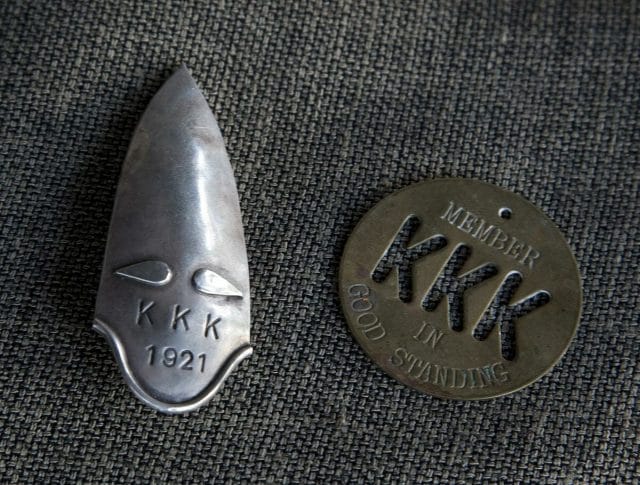
The 1920s KKK made a lot of money selling robes, memorabilia, candy, and life insurance policies to its own members
Today, the Ku Klux Klan is one of the most extreme and reviled symbols of American racism. But there was once a time when the fringe hate group verged on “mainstream.” In the 1920s, its members numbered in the millions and made up a significant percentage of the US population. This is the KKK that claimed to control elections and counted U.S. presidents among its members. And it’s the predecessor to the group that, in fiction, threatened Atticus Finch in front of the steps of the Maycomb County courthouse for defending a black man.
But in 2011, Roland G. Fryer and Steven D. Levitt, the economist co-author of Freakonomics, looked into historical statistics about KKK membership and demographic, criminal and political trends at the time. And they found something surprising: a seldom-seen side of the KKK.
“Rather than a terrorist organization,” they wrote, “the 1920s Klan is best described as a social organization with a wildly successful multi-level marketing structure.” According to Fryer and Levitt, in its heyday, the KKK was a giant, perverse pyramid scheme. Instead of perpetrating a racist agenda, the KKK’s leaders exploited pre-existing, popular racism to make money.
They were very, very, very successful. At a time when per capita income in the U.S. was under $700, the Indiana Klan leader pulled in about $200,000 annually. In 2015, that’s the equivalent of more than $2.8 million.
A Brief History of a Hate Group

Still from “The Birth of a Nation”
In December of 1865, six former Confederate soldiers from Pulaski, Tennessee founded the Ku Klux Klan. They started the organization as a fraternal society with ridiculous titles and costumes. They dressed in sheets and rode around on horseback for fun, pretending to be ghosts.
“Their problem was idleness, their purpose amusement,” historian David Mark Chalmers writes in his book Hooded Americanism: The History of the Ku Klux Klan.
That levity did not last long. The Klan soon discovered that their childish pranks frightened newly freed blacks. Others noticed this and donned their own sheets. Some of these new “members” were more bent on terrorism and intimidation than amusement. “The time was ‘rotten-ripe’ for the development of the Klan as a means to control the newly freed Negro and his Northern friends,” Chalmers writes. In 1867, Klan representatives from several cities convened in Nashville to establish what Chalmers calls an interstate, “self-appointed police organization.”
Rather than amusement, the new, larger Klan saw its purpose as vigilante ‘justice.’ And, as Chalmers writes, “The method of the Klan was violence. It threatened, exiled, flogged, mutilated, shot, stabbed, and hanged.” The group’s sense of ‘justice’ was grounded in the culture of the antebellum South. Their victims included black people, Northerners, and basically anybody who opposed the KKK’s white supremacist vision for society.
In 1870, the federal government declared that the KKK was a terrorist organization. The government busted up the group by issuing hundreds of indictments, and prosecuting members and leaders. By 1872, the group had been broken, and the robes had disappeared.
In 1915, D.W. Griffith released the film “The Birth of a Nation.” Griffith’s movie follows the Northern and Southern branch of the same family through the Civil War and the Reconstruction Era. In the film, the South is overrun by aggressive and unintelligent freed blacks after the war. The KKK is portrayed as a heroic, masked force — a precursor to modern superheroes — that restores order to the South and defends white Southern women.
Although Griffith’s film is a radical perversion of the facts, it’s more or less the exact narrative purported by the Dunning School of history, which was prominent at the time. And the film itself, partially as a consequence of the public controversy it stirred, was wildly popular. It’s estimated to have made more than $60 million at the box office in its first run.
Much like how “Swing Kids” inspired a swing dance revival in the 1990s, or the Harry Potter films inspired the creation of intercollegiate quidditch leagues, “The Birth of a Nation” inspired a 20th Century KKK revival.
On Thanksgiving Day, 1915, William Simmons, a doctor from Georgia, led a group of 34 men on a trip to Stone Mountain. There, they burned a cross — a ritual that was in “The Birth of a Nation, but never practiced by the original KKK — and Simmons declared himself the “Grand Wizard” of a new KKK.
The Business of Hate
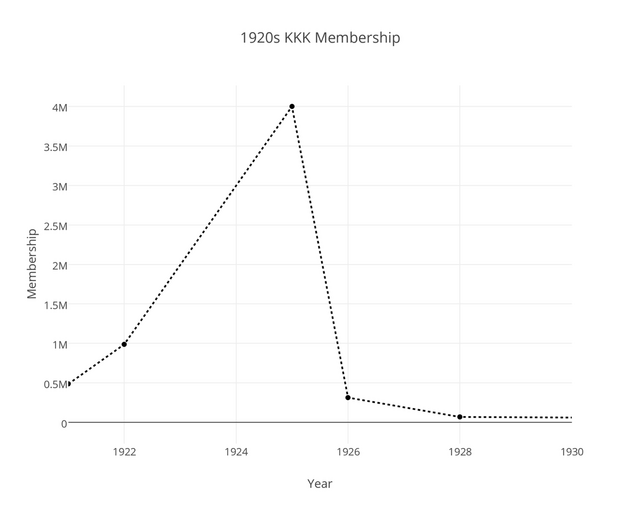
KKK membership peaked in 1924 at close to 4 million members (Levitt and Fryer)
For their research, Fryer and Levitt compiled a database of historical KKK documents, including internal censuses, member applications, and robe order forms. They cross-referenced the names on these forms with data from the 1920 and 1930 American Censuses.
From this database, which is consistent with previous analyses, we know that this new KKK didn’t really take off until about 1920. Then membership suddenly — and somewhat mysteriously — boomed. Estimates of the KKK’s size at its peak in 1924 range from 1.5 million to 4 million — 4-15% of the eligible population.
According to Fryer and Levitt, this boom was the result of an innovative new marketing campaign.
In December of 1920, the KKK hired a PR firm, the “Southern Publicity Association,” to boost recruitment. The firm had previously represented the Salvation Army and the Anti-Saloon League, but it was close to bankruptcy.
The incentives in the contract were good, possibly too good. Simmons had always made money off his Klansmen. He sold them $6 robes and Klan-branded life insurance policies at $53,000 a pop. He also charged his members $10 initiation fees. According to the contract, the Southern Publicity Association would get 80% of this initiation fee for every new member it signed up.
When the Southern Publicity Association signed on, the full initiation fee was still $10, roughly equivalent to $125 in 2015. Eighty percent of the fee was $8, and roughly equivalent to $100. This meant the Southern Publicity Association could offer salesmen an attractive commission while keeping a substantial cut.
The Southern Publicity Association quickly built and deployed a national sales force of over 1,000 “Kleagles” — the KKK’s name for its commission-paid salesmen. Every time a Kleagle recruited a new member (called a “Ghoul”), the Kleagle earned $4 of the $10 initiation fee. At first, the Southern Publicity Association sent $2 of the remaining $6 to Simmons, pocketed $2.50, and handed $1.50 to a regional supervisor called the “Great Goblin.”
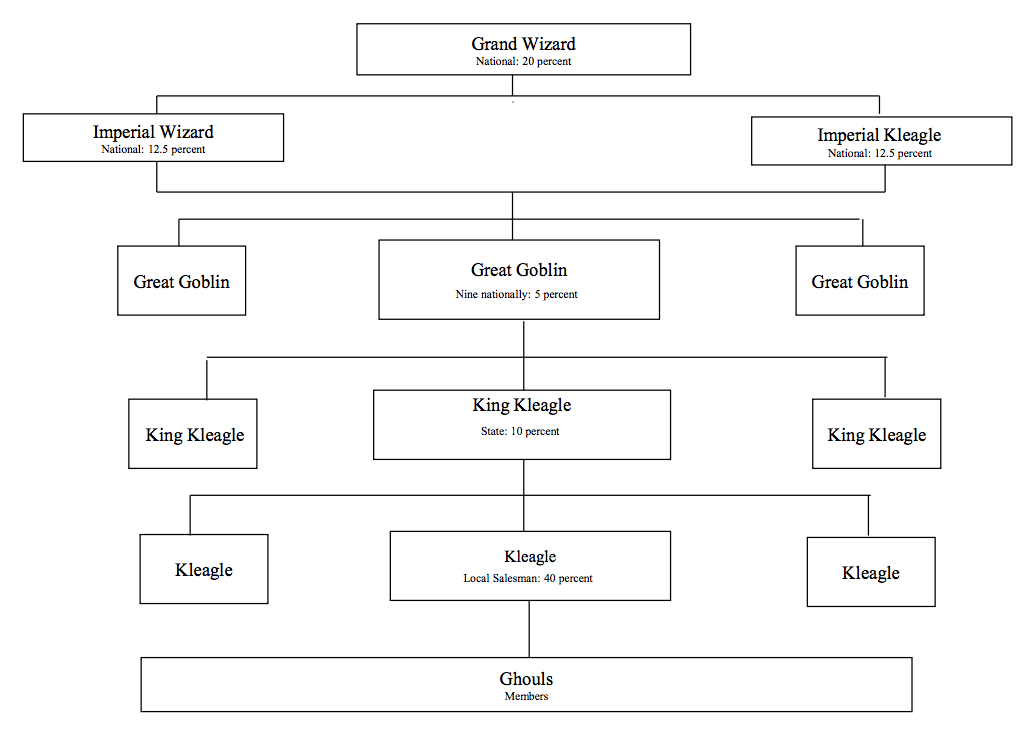
The KKK’s recruiting and payment structure, Levitt and Fryer 2011
Soon, the whole KKK adopted the $4 Kleagle scheme, and the entitlement chain got longer. The economic structure that eventually arose looked much like a modern multi-level marketing company–with extremely stupid titles.
The Southern Publicity Association was joined by a whole tier of “King Kleagles,” who were responsible for overseeing recruitment in each state. The King Kleagle’s share of the remaining $6 was reduced to $1. Fifty cents went to the Great Goblin, $1.25 went to a national sales manager called the “Imperial Kleagle.” Another state-level authority, the “Grand Dragon”, who was more in charge of governance than recruitment, collected $2.50, and the two heads of the KKK — Grand Wizard Simmons, and another executive, titled the “Imperial Wizard,” split the remaining $0.75.
The group expanded, and new Kleagles were recruited from among the Ghouls. According to Levitt and Fryer, Kleagles went into untapped markets with the charge to “make salient whatever prejudices – anti-Catholicism, anti-Semitism, racism, and so on – were most acute in the particular areas they were selling Klan memberships.” They did, in exchange for 40% of the sale. But there were more profits to be made off each new recruit.
Today, the U.S. government distinguishes “legitimate” pyramid selling from an illegal pyramid scheme based on whether a company makes most of its profits from its customers, or from its members/employees. While the KKK was, in most respects, a “non-profit” dedicated to championing a political and social “cause” (racism and xenophobia), it exclusively made money off its members. The Klan sold to the Klan, and the Klan alone.
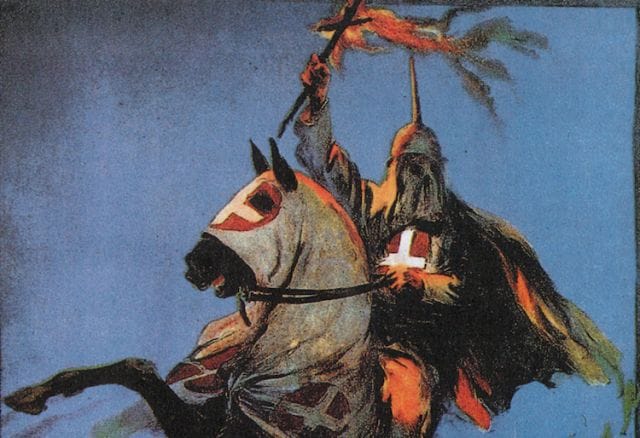
From the “The Birth of a Nation” theatrical release poster (Wikipedia)
And the Klan sold to the Klan a lot. Once a new member joined, he was not allowed to make his own robes. KKK robes only came from KKK-approved factories. They cost $2.00 to produce, and they were initially sold to members for $6.50 (about $88 in 2015). The KKK also pressured its members to purchase a lot of other racist-branded swag: life insurance, robe dry-cleaning services, helmets, Bibles, swords, and “even specially-wrapped candies with the Klan insignia on it.”
Members also paid an annual membership fee of $5, and KKK leaders collected an “imperial” tax on all officially chartered local chapters (also known as “Klaverns”) of $1.80 per Klansman, paid out in four parts of $0.45 a year. This money went directly into the inner “Imperial” rung of the hierarchy. For a time, the Klan leaders, even at the state level, were among the best paid men in America. From Fryer and Levitt:
“[T]he single state of Indiana generated nearly $4 million in revenues for the national headquarters. After some modest expenses, most of that revenue would go directly to the Imperial Wizard. […] [T]he head of the Indiana Klan received nearly $2.5 million annually from the state’s operations. The head of the state sales hierarchy pocketed nearly $400,000 a year. To put these numbers into perspective, in current dollars, a typical full professor during this time earned $45,000 in current dollars (Bachman 1929), Babe Ruth earned $613,000, and President Calvin Coolidge earned $885,000.”
A Surprisingly Ineffective Hate Group

“Grand Dragon” D.C. Stephenson’s 1925 conviction for rape and murder caused the KKK to collapse (Wikipedia)
Pyramids like the KKK only survive for as long as they can expand. And, because they grow exponentially, that isn’t long. At their largest, they’re particularly vulnerable to the disintegration of interpersonal bonds, especially among the leadership.
The KKK’s popular collapse came in 1924 and 1925. D.C. Stephenson, the “Grand Dragon” of Indiana and several other states, was a charismatic figure considered largely responsible for the KKK’s widespread popularity in his home state. Fryer and Levitt estimate Klan membership in Indiana at almost 19% of the eligible population — nearly 1 in 5.
But America would soon discover that D.C. Stephenson was not the squeaky-clean, Protestant, prohibitionist, nationalist white-supremacist he claimed to be.
In 1925, Stephenson was tried and convicted of the rape and murder of Madge Oberholtzer, a young state employee. Following her abuse by Stephenson, Oberholtzer had received medical attention too late to save her life, but she told all in a signed statement on her deathbed. The judge found that Stephenson had kidnapped Oberholtzer, forced her to drink liquor, raped and physically abused her, and caused her death.
When the Stephenson scandal broke, members fled the KKK in droves. By 1930, national KKK membership was back down to 30,000.
Levitt and Fryer see this sudden collapse as evidence that the KKK was a fundamentally weak organization — a profit-driven scheme rather than a true ideological group. Levitt and Fryer write:
“Whether [a] new member remained active in the Klan for many years, or provided public goods to the organization, was immaterial to the Kleagle. This fueled the growth in membership during the ascent, but resulted in an organization in which the level of attachment of the typical member to the group was likely to be weak, compared to other social groups.”
They also found that even in its heyday, when it came to affecting policy and culture, the KKK was surprisingly ineffective. With historic political groups and movements, it’s hard to separate correlation from causation. As Levitt and Freyer say, the KKK may have thrived, “in places where hate crimes would have occurred regardless of their presence.” To look for evidence of the KKK’s causal impact, Fryer and Levitt compared the 1910s to the 1920s, regions with a strong KKK to regions with similar nativism and white supremacism but a weak KKK, and the early 1920s to the period after the KKK’s sudden implosion.
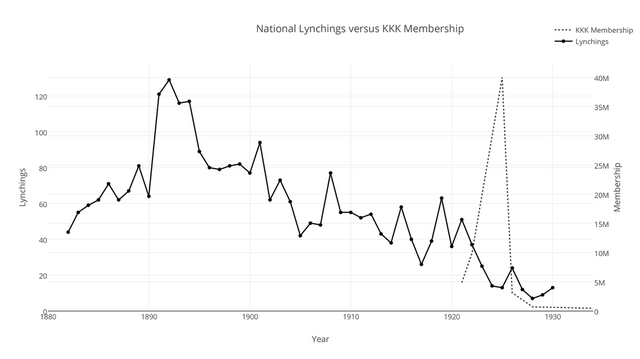
US lynchings graphed against national KKK membership, Levitt and Fryer 2011
Based on this analysis, Fryer and Levitt conclude that “contrary to conventional wisdom, the Klan had little impact on Black or foreign born migration, lynchings, or politics during [the 1920s.]”
They add: “Moreover, even when the Klan succeeded in the electoral process, there is little evidence that the legislation that got passed effectively advanced the Klan’s mission.”
To be clear, there were hate crimes and widespread, systematic bigotry in the 1920s era south. But what Fryer and Levitt’s research suggests is that the KKK as an organization didn’t have much of an impact on these phenomena. While this is shocking to those of us who think of the KKK as a brutal terrorist group, it is less-so when you think of it as a pyramid scheme “fueled by an army of highly-incentivized sales agents selling hatred, religious intolerance, and fraternity in a time and place where there was tremendous demand.”
“The Klan’s true genius,” Fryer and Levitt conclude, “lay in its uncanny ability to raise revenue.”
Though the target of federal scrutiny for years, the national KKK was finally taken off the American political stage in 1944, when the federal government sued the organization for $685,000 in back taxes. Since then, splinter groups using the same brand have sporadically resurfaced, but the KKK, as a national organization, has never returned.
Taxes might seem like a strange end to a national terrorist organization. But there are few better ways to shut down a pyramid scheme than to tax it out of business.
***
Our next article investigates why school construction financing is a fee bonanza for investment banks. To get notified when we post it → join our email list. A version of this article originally appeared on December 22, 2015.
![]()
Note: Priceonomics can help your company get better at creating content marketing that actually performs. Software, training and content creation services from Priceonomics. Starting at just $49 / month.



